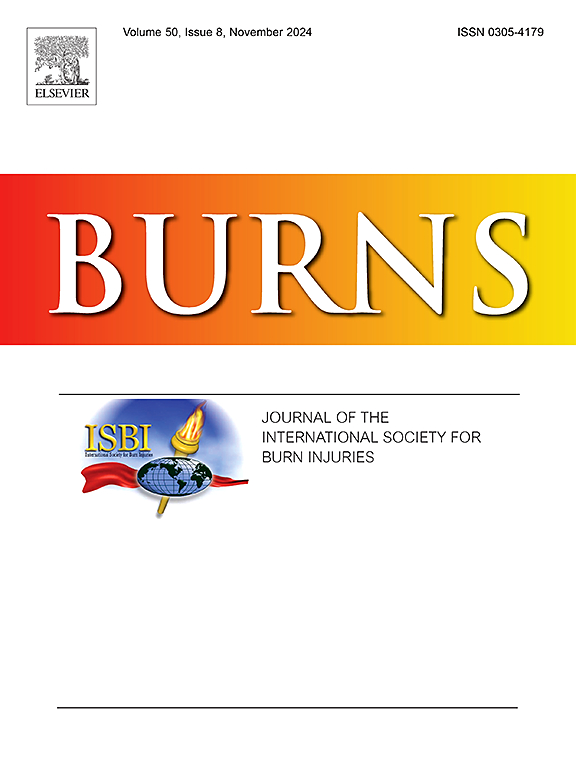土耳其烧伤患者12项瘙痒严重程度量表的效度和信度研究
IF 3.2
3区 医学
Q2 CRITICAL CARE MEDICINE
引用次数: 0
摘要
烧伤后的刺痛感对患者有生理、心理和社会影响。烧伤患者瘙痒的客观评估是一个问题,其中最重要的障碍之一是缺乏适当的评估标准。本研究旨在检验“12项瘙痒严重程度量表”的有效性和可靠性,该量表用于评估土耳其人群烧伤创伤个体的瘙痒严重程度。研究数据于2019年1月至6月在一家城市医院烧伤中心的烧伤门诊收集。该研究纳入了2018年9月以来18-65岁的烧伤患者120例,根据VAS评分,瘙痒严重程度为1或更高,烧伤出院后至少15天在烧伤门诊随访。采用“12项瘙痒严重程度量表”收集研究数据。采用语言效度、内容效度、收敛效度和内部一致性分析对量表进行效度和信度研究。结果量表的内部一致性信度系数为0.79。量表第7项与量表总分不相关(p >; 0.05),其余11项与量表总分正相关(p <; 0.0001)。采用VAS评估量表的并发效度,效度系数较高(p <; 0.0001)。结论根据研究获得的数据,适用于土耳其人群的“12项瘙痒严重程度量表”适用于烧伤创伤个体是有效和可靠的。本文章由计算机程序翻译,如有差异,请以英文原文为准。
Validity and reliability study of 12 Item Pruritus Severity Scale for Turkish patients with burns
Aim
Itching sensation after burn injury has biological, psychological, and social effects on the patient. Objective assessment of itching in burn patients is a problem and one of the most important obstacles is the lack of adequate assessment criteria. This study was conducted to examine the validity and reliability of the “12 Item Pruritus Severity Scale” developed to assess the severity of itching in individuals with burn trauma for the Turkish population.
Method
The study data were collected between January and June 2019 at the burn outpatient clinic in the Burn Center of a city hospital. The study included 120 patients in the age group of 18–65 years who had suffered a burn injury since September 2018, whose pruritus severity was 1 or higher according to VAS, and who were followed up in the burn outpatient clinic after being discharged at least 15 days after the burn injury. The data of the study were collected with a “12Item Pruritus Severity Scale”. Language validity, content validity, convergent validity and internal consistency analysis were used for the validity and reliability study of the scale.
Results
The internal consistency reliability coefficient of the scale was found to be 0.79. The 7th item in the scale was not found to be correlated with the scale total score (p > 0.05), while the other 11 items were positively correlated with the scale total score (p < 0.0001). The concurrent validity of the scale was evaluated with VAS and the validity coefficient was found to be high (p < 0.0001).
Conclusion
Based on the data obtained from the study, the “12 Item Pruritus Severity Scale” adapted for the Turkish population was found to be valid and reliable to be applied to individuals with burn trauma.
求助全文
通过发布文献求助,成功后即可免费获取论文全文。
去求助
来源期刊

Burns
医学-皮肤病学
CiteScore
4.50
自引率
18.50%
发文量
304
审稿时长
72 days
期刊介绍:
Burns aims to foster the exchange of information among all engaged in preventing and treating the effects of burns. The journal focuses on clinical, scientific and social aspects of these injuries and covers the prevention of the injury, the epidemiology of such injuries and all aspects of treatment including development of new techniques and technologies and verification of existing ones. Regular features include clinical and scientific papers, state of the art reviews and descriptions of burn-care in practice.
Topics covered by Burns include: the effects of smoke on man and animals, their tissues and cells; the responses to and treatment of patients and animals with chemical injuries to the skin; the biological and clinical effects of cold injuries; surgical techniques which are, or may be relevant to the treatment of burned patients during the acute or reconstructive phase following injury; well controlled laboratory studies of the effectiveness of anti-microbial agents on infection and new materials on scarring and healing; inflammatory responses to injury, effectiveness of related agents and other compounds used to modify the physiological and cellular responses to the injury; experimental studies of burns and the outcome of burn wound healing; regenerative medicine concerning the skin.
 求助内容:
求助内容: 应助结果提醒方式:
应助结果提醒方式:


